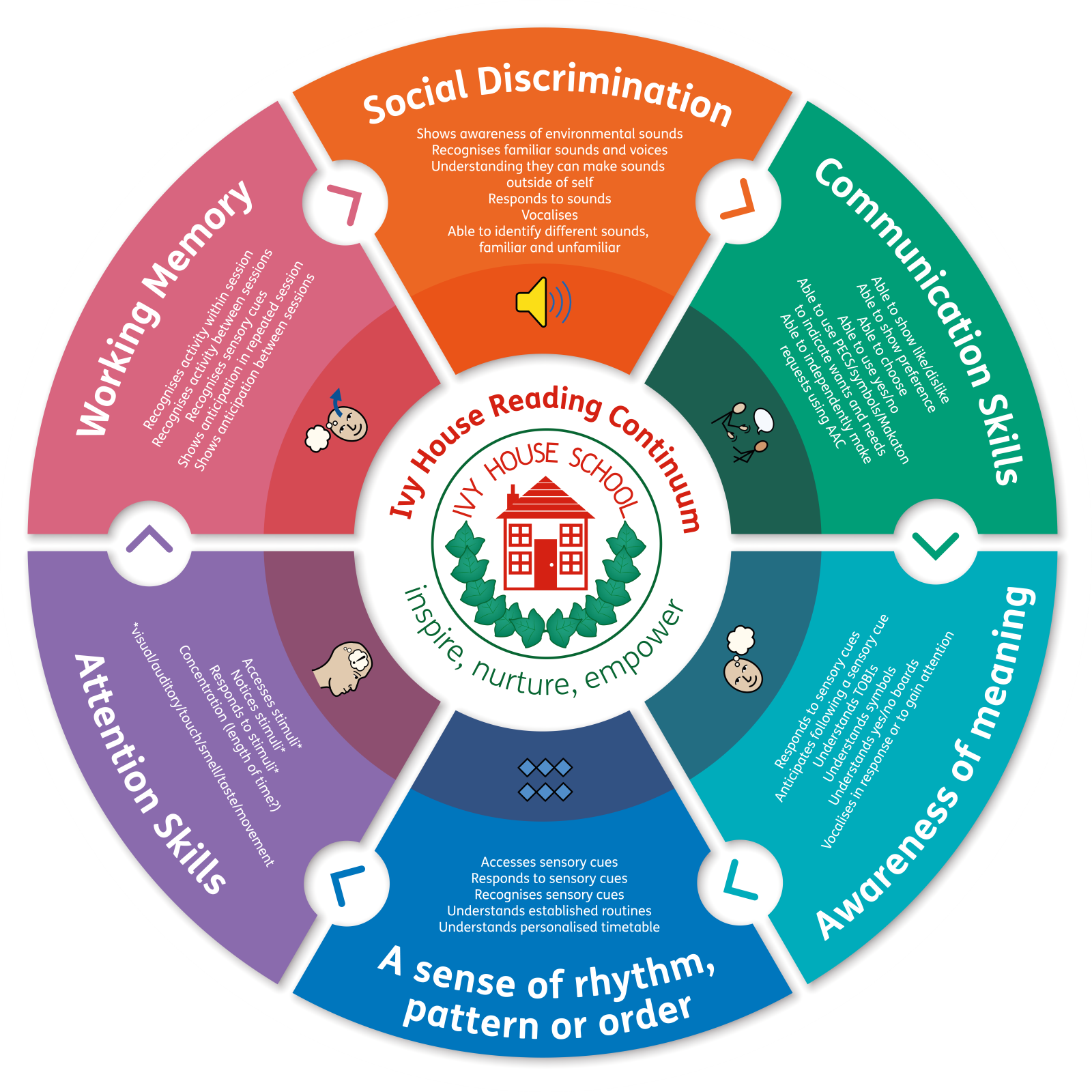Reading at Ivy House
Intent
At Ivy House, we encourage all pupils to develop a love of reading. Developing reading skills enables our children to access meaning from different forms: rich and varied language, text, symbols, expressions, objects, pictures, people and the environment. The pre-requisite reading skills we strive to develop in our students provide a foundation for the development of word recognition and language comprehension.
We aim to promote a love and passion for reading and the world of literacy for all our learners. We know reading provides a gateway to learning and provides all learners with access to rich experiences which may exist outside of our learners’ immediate world. Reading and access to literature has proven to have a positive effect on our wellbeing and therefore needs to include all leaners. We begin from the position that we presume competence for all of our learners. We provide learners with the opportunity to begin to learn this continuum of skills to provide a new world of experiences and opportunities. High expectations and aspirations are at the heart of all we do.
We view every child and young person in our school as a ‘reader’. Everyone has access to a rich diverse literacy environment full of poetry, drama, stories, personal narratives, fiction and non-fiction, whilst recognising each learner’s preference and engagement with the text/story. The access to a wide variety of text is at the core of our reading curriculum, ensuring that all learners are able to experiences all forms of language and storytelling as they move through the school, from EYFS to our 14-19 department.

Implementation
The journey to becoming a reader begins with the development of prerequisite skills to learning which include: engagement; communication skills; awareness of meaning; attention skills; a sense of rhythm, pattern and order; memory retention; and sound discrimination.

We embed a joy of reading by creating a curriculum that is built on individual pupils’ interests and enables all learners to access the world of literacy regardless of their personal disabilities or barriers to learning. Our inclusive reading curriculum uses a wide variety of resources, skills knowledge and multi-sensory approaches, including; sound boards, story massage, sensory stories, pictures/symbols/TOBIs, sensory props, communication aids and more. Our staff play a vital role in ensuring that a love and enthusiasm for reading is generated in our learners by using individualised approaches and the understanding that our staff have of each child that they work with.
Engagement is the key to all learning and is a key element of our reading curriculum. We use the Engagement Model to observe and record what our pupils are interested in, what they want to explore and engage with and how we are able to promote their engagement in all forms of learning. We adapt activities to suit each individual children’s interests and motivations. All pupils have individual targets linked to their EHCP outcomes. Therefore, Ivy House has a literacy rich environment that develops motivation and engagement, embedding our pre-requisite skills in the day to day school routine.
Our pupils take different pathways depending on their individual needs, pupils who are working on the pre-formal curriculum and use the Engagement Model as part of their assessment work on pre-requisite and emergent reading skills that are intertwined in all our practice. Our semi-formal learners are beginning to use more formal phonics sessions in line with Read, Write, Inc. As a school we are passionate about the inclusive nature of all of our teaching and therefore our phonics sessions are differentiated to meet the needs of all pupils. We are working alongside other schools and researching the most effective methods of both teaching and assessing phonics knowledge with pupils with additional needs, including our profoundly deaf pupils.
Every person goes through 4 stages to successfully read:
- Input stages: Taking in sensory input from the environment, including; text, hearing songs and words, touch, smell, taste
- Integration stages: Using the information their senses have gathered, beginning to make sense and differentiate different sensory input
- Memory stage: Short term working memory and long-term memory. Short term working memory turns into long term memory following repetition. Beginning to make sense of the information they have received and remember both within and between sessions.
- Output stage: Use the information they have received, understood and remembered to express themselves. Learners use their individualised ways of communication, including yes/no bands, PECs, symbols and many more.
Staff use a wide variety of personalised and differentiated methods of teaching to ensure every pupil is able to access the input stage and build upon this through repetition and consistency to move through the 4 stages to become a successful reader. Although not every pupil may reach all 4 stages we have aspirational targets for our pupils and this is reflected in our practice.
Pre-Formal
Our pre-formal reading framework is integrated as part of our communication curriculum. We teach literacy alongside communication from the beginning of school in the EYFS through to our 14-19 department. We use reading activities to encourage and support our pupils to use their personal communication systems to show awareness, make choices and engage in the story. During our reading sessions we recognise that the shared activity promotes communication. In order to communicate effectively you need to be engaged and to want to make a connection. Reading stories provides a rich vocabulary, develops listening and comprehension skills and reinforces learning through repetition. There is also a sense of ‘belonging’ which promotes mental health and well-being through a shared narrative. We also recognise the importance of developing a sense of rhythm and the flow of a story within our pre-requisite curriculum and so combine communication reading activities alongside reading sessions where the pupils will be read to, and hear rich and varied language. This combination promotes both communication and a love of reading and literature.
At the basis of all reading is the understanding that one thing can represent another, Ivy House has a fantastic range of communication methods to help our pupils to make sense of their day, communicate both through informal and formal methods and use resources and technology, these include: having consistent and established routines, using sensory cues, participating in intensive interaction, reading sensory stories, reading books, singing rhymes and using Alternative and Augmentative forms of Communication (yes/no bands, symbols, signing, eye gaze).
Semi-Formal
Our pupils who are moving onto our semi-formal curriculum have a secure understanding and demonstration of all pre-requisite and emergent reading skills. The pupils will then move onto to the use of Read, Write, Inc. phonics, adapted to meet their own individual needs.
Read, Write, Inc. is a DfE validated systematic synthetic phonics programme that was first created in 2002 by Ruth Miskin. RWI is a programme created for pupils who are learning to read (and write) from reception onwards. It helps children to hear, identify and use different sounds that distinguish one word from another in the English language. At Ivy House, we use an adapted version of RWI to teach to the needs of our individuals. We follow 3 pathways of RWI phonics adapted to the individual needs of the pupils:
Verbal pathway: Our verbal pupils will follow a neuro-typical Read, Write, Inc. phonics program, with adaptions made to ensure that each letter sound is fully understood before moving onto the next one. Pupils at Ivy House require lots of repetition and rehearsal of new learning to ensure a deep understanding and recall. As such our phonics plans to teach a letter sound at a pace that is appropriate to each pupil and then assess how each pupil is able to engage within the session and recall the letter sounds between sessions, if a pupil needs additional time on a letter sound or can move through the phases more quickly, it is adapted to suit the needs of each individual pupil and their learning. As pupils move through the phases of phonics appropriate reading books will be sent home with them, following confident reading in class, to support family engagement with reading.
Non-verbal pathway: Pupils who are non-verbal follow the same phonics teaching but their assessment methods alter so that we are able to properly assess their understanding both of the letter sounds and their ability to identify these sounds in words. Pupils will also be taught using “say the sound in your head” phrases rather than aloud. The approach will be as with our verbal pupils; building and applying skills and knowledge with regular review of previous learning. We have worked alongside Saxon Hill on their non-verbal teaching of reading techniques including the diagnostic distractor array to ensure good practice of both teaching and assessment of knowledge and comprehension for our non-verbal pupils. When a teacher feels it is appropriate and the pupils have a good understanding of some letter sounds and the routine of a phonics lesson, parents will be invited into school to observe a lesson and work with the teacher to find the best ways to put this into practice during home learning activities.
Sensory impairment pathway: A number of pupils at Ivy House have a profound hearing impairment. Teaching reading must be adapted to suit the needs of each pupil and as such we have sought advice from the Royal School for the Deaf and the Guidance for Teachers of Teaching Phonics to Children produced by the National Deaf Children’s Society. The pupils with a profound hearing impairment will be taught in an appropriately quiet and distraction free environment taking into account that they will need either a differentiated or completely different approach to teaching reading based upon their level of hearing. We understand and consider in our teaching that pupils with a hearing impairment are likely to have delayed language acquisition and a less developed auditory memory, and therefore, will require a different and slower approach to the teaching of phonics and reading. At Ivy House we understand that language acquisition is key for a profoundly deaf child to begin to be a reader, and therefore, ensure to offer a range of supportive strategies to develop language such as Makaton, symbols and sensory cues. Some of our children will learn to read through sight reading, such as when removing the symbol and leaving the word for familiar parts of the day, as with a profoundly deaf child they may not be able to develop sound discrimination in a way so as to make it appropriate for the teaching of phonics. In these cases, advice will be taught from the Qualified Teaching for Hearing Impairment who works with the pupil.

Impact
All pupils, regardless of their disability or any barriers to learning, deserve the opportunity to be a reader and the curriculum at Ivy House School recognises and develops the skills they will need to do so. The literature curriculum from EYFS to our 14-19 department ensures that all pupils are exposed to rich and varied language and a variety of texts.
Through the use of the reading continuum, alongside the Rainbow Profile, Engagement Model and RARPA schemes of work, we are able to track each individual pupil’s progress towards the pre-requisite and emergent reading skills. This supports our understanding as educators of when the right time to move a pupil onto more formal phonics is, and ensures that each pupil has the skills they need to be able to access phonics and reading.
Our adapted and personalised phonics pathways mean that every learner is able to access the right form of phonics teaching for them and is able to make good progress towards reading in all its forms.

